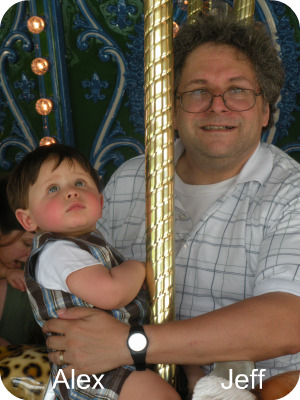main: April 2010 Archives
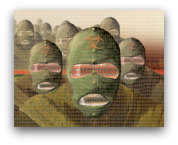 days. If you called up our web address, you were probably greeted with a red box containing a warning that if you continued, your computer would blow up, you would break out in a rash, your crops would fail and your dog would die. Or something like that. We were victims of a malware (malicious software) seige that took days to break.
days. If you called up our web address, you were probably greeted with a red box containing a warning that if you continued, your computer would blow up, you would break out in a rash, your crops would fail and your dog would die. Or something like that. We were victims of a malware (malicious software) seige that took days to break. Since the Rifftides entry about Gene Lees' death on April 22, we have received a flood of comments. They are posted in the comments section at the end of that piece. A couple of days later, Gene's friend Jeff Sultanof sent me a message that he intended as a private communiqué. I was moved by it and persuaded Jeff to revise it as a guest column. My intention was to post it four days ago, but the malware Darth Vader made that impossible.
Jeff is a composer, orchestrator, editor and researcher of great standing in the community of professional musicians, critics and academics. He is an expert on the music of Robert Farnon, Harry Warren, Miles Davis and Gerald Wilson, to name a few musicians whose work he has studied, edited and taught. While it flourished, he was a major contributor to jazz.com and would have written about Gene for that estimable site if it was still publishing new material. The Rifftides staff is honored to present Mr. Sultanof's thoughts about Gene. On the off chance that some readers might not know them, I have taken the liberty of inserting links to a few names. Consider them footnotes.
On Gene LeesBy Jeff Sultanof
Gene's death brings up so much for me, because he was a giant of a man. But as you also know, Gene was far from a simple person, and I saw many sides of him; anyone close to him saw them too. So I thought I would share some reflections of my relationship with Gene. Several of us were close to him and considered him a close friend. That was a challenge at times, as his anger and stubbornness sometimes frustrated us so that we didn't speak to him for periods of time.I knew about Gene for a long time before I finally met him. In either High Fidelity or Stereo Review (they are a blur in my mind at this moment), he wrote these incredible articles that I devoured when I was a young teenager. He discussed the kind of music I loved, and wrote about it so eloquently. I well remember a column he wrote praising an album called Threshold by Pat Williams, and it was his rave that got me to pick up a copy at the late lamented Sam Goody store at Rockefeller Center. The album was as wonderful as he said, so I followed him wherever he wrote. I bought his books of essays from the JazzLetter, and eventually I subscribed.
I finally met him when I was in the midst of a project that I now call my exercise in futility: the editing and cleaning up of the music of Robert Farnon. Nobody wanted to do it, nobody wanted to pay for it, yet it needed to be done. Farnon wasn't going to live forever, and many of his pieces were unavailable in the United States. The man who was considered one of the finest composer/arrangers in the world, praised by Andre Previn and John Williams had a body of work which was a mess. If it was to be played, it needed some tender loving care. I visited him in England and soon his scores
began to arrive at my doorstep. We sent scores back and forth, my sending him newly-copied and edited full scores, he correcting and making them definitive by putting down what he actually wanted. I wrote to Gene and told him about this project, and he asked me to come visit if I ever got out to California. Upon arriving in Los Angeles, I made the first of many trips north to Ojai soon after. We had lunch, and at the end, he asked me whom I wanted to meet; he would call for me. I immediately thought of his neighbor Roger Kellaway, who arrived five minutes later as he had many questions about Farnon's music. Gene put me on the phone with Johnny Mandel, who asked if I had "Lake of the Woods" (I did). He called Jo Stafford to ask if I could come to see Paul Weston (I spoke to him on the phone later that day).
Gene and I communicated regularly from that point on. He asked me to write about Budd Johnson when he found out that Budd was the director of our jazz band and I was his assistant. This became a contribution to the Jazzletter, the first professional article of mine on American music that was published in the United States. He next wanted an article on George Handy. These two pieces were the most important prose works I'd written up to that point. He taught me how to refine my writing, to make it clearer, how to draw the reader in. He was delighted that I knew a great deal about film and film music history, and we discussed his close friend, the brilliant Hugo Friedhofer at length ("He would have liked your seriousness," he told me). I located copies of films that he wanted to see. Whenever I was in California, he, I and Janet would be up till all hours talking, arguing and laughing. He eventually shared a lot of confidences with me.
When he was asked by a conductor friend of his to come up to Montreal and sing in concert, he got Roger Kellaway to write arrangements and accompany him. I asked if I could write something, and wouldn't you know he told me that I should do "Desafinado." I was in shock, but I sat down and did it. I offered to copy parts for all of the arrangements. I was no fool; it was a way for me to study the work of Kellaway and Allyn Ferguson. He obtained an arrangement by Claus Ogerman that originally had a board fade and needed an ending. I happily supplied it.
During a dinner a few days before the concert, I was saying how I was lucky to be part of this concert because my work wasn't as good as either Kellaway's or Ferguson's. Gene lit into me. "Every arranger wants to be in the club of those who really have talent, and many never make it. Others keep beating themselves over the head worrying about it. Jeff, you're in the club, so stop it already." Kellaway grinned at this and nodded in agreement. After many years of writing arrangements for print which I'd never heard and nobody ever told me were good or terrible, I finally felt with that one statement that I had made it, something I'd desperately wanted since I was a little boy and my room was filled with the sounds of Nelson Riddle, Billy May, Don Costa and the many others who I hoped I would know when I went into the music business. As it turned out, I did get to know Riddle and many others of my heroes.
It was Gene who introduced me to Marion Evans, master arranger and teacher of J.J. Johnson, Pat Williiams and Torrie Zito. Marion took to me like a long lost buddy, and when I was asked to write something for the Palm Beach Pops, I called him to have lunch with me and to look at my score. He had just retired from developing computer
programs for Wall Street firms and probably hadn't looked at a score page in years, but he invited me up to Connecticut. That day I got the best orchestration and arranging lesson in my entire life, and when he was through, Marion said, "I didn't realize you were such an accomplished writer," in that quiet, southern drawl of his. It was Gene who told me, "You realize that that statement is like winning the Academy Award." It wouldn't have happened if it wasn't for Gene.
I also saw his ugly side; as you know, simple things would make him fly into a rage. Disagreements with him by colleagues including the late Richard Sudhalter would bring out the warrior who would write on and on in the Jazzletter that these people were wrong and how could they be so misguided. I once asked my friend Richard how one handled being attacked that way. "It's just Gene," he said. "We've all been through it. I'll call him or he'll call me in a couple of months and straighten it all out." I myself got a phone call I'll never forget. He insisted that he would never confide in me again. I asked him what happened. After screaming and going on a bit, he insisted that I'd told someone something that was not for their ears. Patiently and quietly, I laid out my case why I was not the one who'd said anything, and when he calmed down, he figured out who the culprit was. He quietly apologized, asked me how I was and said he'd talk to me later. Amazing!
He was deeply burned by Jobim. He explained that in order to write the lyrics to Jobim's songs, he learned Portuguese so that he could give the actual meaning of the songs in English. As you know, several of them are brilliant. He always felt they should have made him more money, and always spoke of researching each copyright so that he could figure out how much was owed to him. He probably was owed quite a bit, but
between the original copyrights and the rights for different groups of countries, these waters were muddy indeed, and he didn't have the patience to do the research himself. Jobim wound up getting most of his songs back in the U.S., and even wrote English lyrics for his new songs, which weren't very good. Jobim treated him quite shabbily, to hear Gene tell it; he wrote of this in the JazzLetter. So often in a conversation, he would bring up Jobim, and I could tell that this was one of the great disappointments of his life.
It was Gene's hatred of rock that probably alienated many influential people who could have hired him. Who knows how many songs he heard that he turned down, pissing off people along the way? This reminds me of Bernard Herrmann's remark to a filmmaker who wanted Herrmann to score his new picture. Herrmann, an outspoken man himself, said, "Why do you show me this garbage?" If I could have given a gift to Gene, it would have probably been a hooked rug with that quote. I know that he would have laughed.
When he turned philosophical, he considered himself a failure. He believed that he was preaching to a congregation that was dying off, and that younger people didn't care about the music he loved. I assured him that many young people did, and that his writings would be treasured by new generations because right or wrong, he was passionate about music and words and wanted to tell us as much as he could about those created these artistic miniatures called songs. Gene's love of language inspired many who read his books and heard his presentations. Deep passion about any art form is to be treasured; many writers want to show off what they know rather than how an artwork made them feel and teach us why it is or was important. If Gene reminds us
of anything, it is that to really write well about art, you must know as much about it as possible and draw the reader in so that he/she must hear or see the material at hand just to see if he/she agrees with the writer. Gene was hardly complacent, and many of his articles demand your participation rather than asking nicely. Sometimes he was way off base and wrote from pure emotion, but more often than not, he could back up his opinion in any number of ways. He knew that being polite often doesn't work, especially today. If we jump in the water and swim with Woody, Alan, Frederick, Dizzy and any number of other people he wrote about, at least it was better than just looking at the water with a cigarette and a drink in your hand. Life's too short anyway.
You, Teachout and a few others are left to hold up this rickety old house with little more than spit and chewing tobacco, and we've just lost one of those whose spittoon was overflowing. More power to you, and let's think of Gene with a smile once in awhile. Let's get out his books and remind ourselves why we loved them. Let's not forget his search for a truth, maybe not a truth that everyone could agree with, but at least an opinion that is well argued and makes sense. In this time of great insanity in our beloved United States, we need this more than ever.
Gene Lees ad Libitum & JazzLetter (its full name) has always been strictly a print venture. There are intentions, but no firm plans, to give it a web presence. The first step is a JazzLetter web site offering subscriptions, back issues and Gene's books. Janet Lees says that more information will eventually follow.
Gene Lees died today. We lost a writer unsurpassed at illuminating music and the world that musicians inhabit. I lost a cherished colleague whose work inspired me, a dear friend whose companionship brightened my existence. For a formal biography, see his entry in The Canadian Encyclopedia. My remarks are more personal.
Gene's books about Oscar Peterson, Woody Herman, Henry Mancini, Johnny Mercer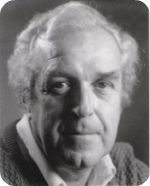 and Lerner and Lowe are among the finest biographies of our time, regardless of category. He was completing a biography of Artie Shaw. I have read some of the manuscript. It is definitive. The collections of pieces from his invaluable publication Gene Lees' JazzLetter are essential books for anyone interested in music. The titles indicate his range: Meet Me at Jim and Andy's, Singers and the Song, Cats of Any Color: Jazz Black and White, You Can't Steal a Gift: Dizzy, Clark, Milt and Nat, Friends Along the Way: A Journey Through Jazz. Jazz Lives is Gene's book of essays about 200 musicians from Spiegle Willcox to Christian McBride, illustrated with photographic portraits by John Reeves, who made the one of Gene that you see here.
and Lerner and Lowe are among the finest biographies of our time, regardless of category. He was completing a biography of Artie Shaw. I have read some of the manuscript. It is definitive. The collections of pieces from his invaluable publication Gene Lees' JazzLetter are essential books for anyone interested in music. The titles indicate his range: Meet Me at Jim and Andy's, Singers and the Song, Cats of Any Color: Jazz Black and White, You Can't Steal a Gift: Dizzy, Clark, Milt and Nat, Friends Along the Way: A Journey Through Jazz. Jazz Lives is Gene's book of essays about 200 musicians from Spiegle Willcox to Christian McBride, illustrated with photographic portraits by John Reeves, who made the one of Gene that you see here.
Some of Gene's lyrics are ingrained in our culture, words to songs by Antonio Carlos Jobim ("Quiet nights of quiet stars, quiet chords from my guitar...") and Bill Evans ("In her own sweet world, populated by dolls and clowns and a prince and a big purple bear..." and so many others. Gene shared his wordsmith knowledge in The Modern Rhyming Dictionary: How to Write Lyrics. He sang, and sang well, in personal appearances and on records.
Here are a few of the things I wrote about Gene in the foreword to the second edition of Singers and the Song.
Most writing about jazz and popular music, as sophisticated readers recognize with a wince, is done by fans who have become writers. Most are cheer leaders, press agents without portfolio who leave in their wakes evaluations and pronouncements supported by raw opinion and nerve endings. ...Gene Lees brings to jazz writing the skills of a trained and experienced journalist. ...He was beaten into the shape of a newspaperman by tough editors who demanded accuracy and clear story-telling.
When in 1959 the opportunity came for Lees to become editor of Down Beat, he was mature in journalism and music. He brought to Down Beat a professionalism in coverage, editing, and style and elevated it significantly above its decades as a fan magazine.
Lees founded his JazzLetter in 1981. He has written, edited, and published it with the rigor of an old fashioned-managing editor who enforces high standards of accuracy, clarity and fairness--he once threw out one of his own pieces at press time on grounds of lack of objectivity--and with the passion of an editorial page editor who cares about his community. ...Like all good editors, he knows his readers and the community they comprise. He knows that his community is part of the world, and he knows how the two interact.
Gene wrote like an angel. This is the opening of his classic essay, "Pavilion in the Rain."
On warm summer nights, in that epoch between the wars and before air conditioning, the doors and wide wooden shutters would be open, and the music would drift out of the pavilion over the converging crowds of excited young people, through the parking lot glistening with cars, through the trees, like moons caught in the branches, and sometimes little boys too hung there, observing the general excitement and sharing the sense of an event. And the visit of one of the big bands was indeed an event.
He had strong opinions about everything. We argued. Arguing was half the fun of knowing Lees. Every argument with Gene was a win for me because I had learned from him.
I hope that he wouldn't mind my adapting his final lines of "Waltz For Debby."
When he goes they will cry
As they whisper good-bye
They will miss him I know
But then so will I.
 In response to yesterday's Rifftides post, music critic Mark Stryker (pictured) of the Detroit Free Press sent a message that included a column he wrote earlier this year. With his permission, we bring it to you.
In response to yesterday's Rifftides post, music critic Mark Stryker (pictured) of the Detroit Free Press sent a message that included a column he wrote earlier this year. With his permission, we bring it to you.
Very nice piece on Billy Childs' new album. I'm anxious to hear it. Billy just wrote a Violin Concerto that was premiered by Regina Carter and the Detroit Symphony in January. I wrote a short preview/profile of Billy in advance of the performance. There's no link, but I've copied it below.
By Mark Stryker
Detroit Free Press
Pianist and composer Billy Childs' musical tastes were forged as a teenager in the early '70s, when musical fusions were as ubiquitous as bell-bottoms. Progressive rockers like Emerson, Lake and Palmer, Gentle Giant and Yes covered classical compositions and wrote 20-minute works from a stew of influences. Jazz groups like Weather Report and Chick Corea's Return to Forever walked an electric-acoustic fault line, creating ambitious marriages of funk, jazz and rock. Conductor Michael Tilson Thomas and the London Symphony recorded with jazz-rock guitarist John McLaughlin. Leonard Bernstein wrote a mass that had everything in it but the kitchen sink.
"It was an era of inter-genre respect, curiosity and tolerance," says Childs, 52. "It shaped my desire to mix genres."Childs' fusion aesthetic underscores his new Concerto for Violin written for the Detroit-born jazz star Regina Carter and co-commissioned by the Detroit Symphony Orchestra. DSO music director Leonard Slatkin will lead the world premiere starting Friday as part of the DSO's annual Classical Roots celebration of black composers and performers.
An elegy in two movements, the concerto draws its emotional inspiration from the Iraq War and the loss of innocent life. Essentially a classical score, the piece also leaves room for the soloist to improvise in a jazz-inspired idiom.Childs made his name as a jazz pianist with trumpeter Freddie Hubbard, vocalist Dianne Reeves and others, but he has increasingly been defined as a composer for orchestra and chamber ensembles. Since 1992 his résumé has filled with commissions from the
Los Angeles Philharmonic, Dorian Wind Quintet, Los Angeles Master Chorale, American Brass Quintet and others. He won a 2009 Guggenheim Fellowship for composition. Childs still works as a pianist, arranger or producer; lately he's been on the road with pop-jazz trumpeter Chris Botti. But the projects closest to his heart are his classical commissions and his Jazz Chamber Ensemble, a sextet with piano, bass, drums, harp, guitar and saxophone (doubling clarinet and flute), augmented at times with strings and winds.
Childs is as comfortable channeling the 20th-Century modernism of Hindemith, Bartok and Stravinsky as he is the contemporary post-bop of Corea and Herbie Hancock. The streams flow together on the 2005 CD "Lyric" by the Jazz Chamber Ensemble. Though some of the music slips into a generic pastoralism, the best works balance perfumed melody, impressionist harmony, detailed counterpoint, intuitive form and improvisation. The 9-minute "Into the Light" unfolds in three sections that suggest a continuous crescendo. Rippling piano provides a ground for singing flute and violin lines, with strings, guitar and harp underneath. There are Ravel-like interludes for string quartet and a piano improvisation over Latin rhythm that ascends to even greater intensity when the ensemble returns with new material.
"A lot of times when people know both classical and jazz worlds really well, when they create it's either one or the other," says Carter. "But with Billy's writing it's become one. It's like a bilingual child who has created his own language."
Carter had been smitten with Childs' writing for years, dating to a concert she heard in which Reeves and an orchestra performed his arrangements. Carter was struck by his
challenging writing for strings and the way he married strong rhythms and grooves with emotion. She asked Childs to write a piece for her, but it took years for him to work it into his busy schedule. Carter and Childs share the same manager, who approached the DSO about commissioning the piece; the work fits seamlessly into Slatkin's agenda of championing sophisticated fusions of classical and vernacular music. The University of Notre Dame, Oakland East Bay Symphony and Boston Pops are co-commissioners.
Born in Los Angeles, Childs was surrounded by R&B, pop and jazz at home. Piano lessons at age 6 didn't take, but he became obsessed with the instrument at 14 while attending boarding school. Returning home to finish high school, he began intensive formal study of classical piano, jazz piano, arranging and theory. Heroes as diverse as Corea, Keith Emerson and Hindemith shaped Childs' desire to work on a broader canvas. So rather than attend an elite jazz school, he studied classical music as a composition major at the University of Southern California. Still, he had enough vocabulary as a jazz pianist to tour briefly with trombonist J.J. Johnson at 19 and start working with Freddie Hubbard a year later.
Stylistic crossbreeding has become viral today, but Childs knows he's part of a jazz-classical continuum that stretches back at least as far as Scott Joplin's ragtime opera "Treemonisha." The line continues through Gershwin and Ravel, mid-century "Third Stream" composers like Gunther Schuller and John Lewis and the fusions of Childs' youth. "We're in that tradition, but this is our twist on it," he says.
"I try to combine the genres at an organic level. I don't like to ask an instrument to do something that has not traditionally proven to be comfortable. If I use a string quartet, I'm going to write idiomatic string quartet music. If I have a drummer, I'm not going to notate every note for the drummer to play. I try to make it the responsibility of the composition to pull off the marriage. I might have a motif in the string quartet that repeats and then someone will improvise over that. Or I might have a fugue but assign it to the bass, piano, guitar and drum set so drums are intrinsically involved."In his earlier works Childs consciously used traditional classical structures like sonata form and theme-and-variation, but now he allows each work to create its own form.
"The hardest part for me -- and the most important part -- is coming up with really good, strong melodic material. A good melody will draw a listener in and make the piece interesting, and a solid structure will engage the listener for a long period of time.
The staff thanks Mark Stryker for loaning Rifftides his work.
Billy Childs, Autumn In Moving Pictures: Jazz Chamber Music, Vol. 2 (artistShare).
There is a long history in jazz of strings in small-group chamber music. In a 1935 concert, Artie Shaw played a piece that he composed for clarinet and string quartet. It brought him attention that helped lead to his first big band. Ralph Burns integrated strings, flute and French horn with his piano, Ray Brown's bass and Jo Jones' drums, for his exquisite 1951 collection Free Forms. Later highlights of the genre were Gary McFarland's album of subtle chamber music with pianist Bill Evans and The October Suite from 1966, with McFarland's compositions and strings arrangements for pianist Steve Kuhn. Along the way there was distinguished music with small string ensembles by Jack Weeks and Clare Fischer for albums by Cal Tjader, Fischer's own Songs For Rainy Day Lovers (included in this CD), Manny Albam's writing for the piano of Hank Jones and the Meridian String Quartet, and violinist Harry Lookofsky's magnificient 1959 Stringsville with Hank and Elvin Jones, Bob Brookmeyer and Paul Chambers.
Add to that distinguished list Autumn In Moving Pictures, the new CD by pianist Billy Childs. Childs is a pianist and composer whose talent far outstrips the recognition he has received for his own work and his associations with Freddie Hubbard, J.J. Johnson, Yo Yo Ma, Eddie Daniels and a galaxy of other musicians. He melds his rhythm section with saxophone or clarinet, harp, guitar, and, on some pieces, winds and the Ying String Quartet. The album's nine tracks amount to a suite inspired when Childs found himself amidst the blazing beauty of fall in New England. Knowing of that stimulation, the listener may easily conjure images of turning leaves, crisp air, rainfall and - in the case of a track inspired by a William Carlos Williams poem - a red wheelbarrow.
However, without reference to what they are "about," Childs' inventions support themselves by dint of compositional craft and the musicianship of the players. The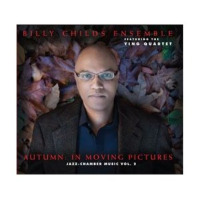 sonorities and harmonic fullness he achieves in blends of the instruments have much in common with French impressionists of the Twentieth century. He dramatically establishes that influence in the opening piece, "The Path Among the Trees," with Brian Blade's cymbal splashes and brushes on drums providing urgency, and guitarist Larry Koonse in a handsome solo. Childs' writing for a passage of the string quartet alone is elegiac, giving way to urgency underscored by the insistency of Blade's drumming. He uses Carol Robbins' harp to carry most of the first chorus of the theme of Bill Evans' "Waltz for Debby" before his piano slips in to finish the chorus and he introduces Bob Sheppard's clarinet, Koonse's guitar, Scott Colley's bass and Antonio Sanchez's drums. He develops a kaleidoscopic treatment that involves solos by individual instruments, combinations of intersecting lines, counterpoint, quick climaxes, changes of tempo and, finally, a peaceful - perhaps autumnal - piano resolution of the theme on a triad.
sonorities and harmonic fullness he achieves in blends of the instruments have much in common with French impressionists of the Twentieth century. He dramatically establishes that influence in the opening piece, "The Path Among the Trees," with Brian Blade's cymbal splashes and brushes on drums providing urgency, and guitarist Larry Koonse in a handsome solo. Childs' writing for a passage of the string quartet alone is elegiac, giving way to urgency underscored by the insistency of Blade's drumming. He uses Carol Robbins' harp to carry most of the first chorus of the theme of Bill Evans' "Waltz for Debby" before his piano slips in to finish the chorus and he introduces Bob Sheppard's clarinet, Koonse's guitar, Scott Colley's bass and Antonio Sanchez's drums. He develops a kaleidoscopic treatment that involves solos by individual instruments, combinations of intersecting lines, counterpoint, quick climaxes, changes of tempo and, finally, a peaceful - perhaps autumnal - piano resolution of the theme on a triad.
"Prelude in E-minor" is not Chopin's, but a composition by Childs that returns to impressionism, with the harp prominent and specific references to Ravel. "A Man Chasing the Horizon" is full of vigor, with Childs bluesy in a section that highlights interaction among him, Sanchez and Colley before the strings and Sheppard enrich the ensemble and raise the intensity. Childs takes full advantage of the harmonic possibilities implicit in the familiar melody of Fauré's "Pavane." There is magic in his voicings around the French horn in the piece's final ensemble. The 16th-note pitter-patter of "Raindrop Patterns" is the purest programmatic expression in the album. In this instance, even not knowing the title, listeners might think of rainfall or, during Sheppard's impassioned soprano saxophone solo, a storm. "The Red Wheelbarrow" features reflective guitar by Koonse, who shines throughout the CD, as, indeed, do all of the musicians.
The publicity material sent with the album goes to pains to present this music as a successor of the third stream and fusion movements of the second half of the last century. If that marketing approach persuades people to listen to it, there is no harm done. If it drives away listeners put off by those labels, that's a shame. Childs' work needs no label. Of the two categories of music defined by Duke Ellington, this falls gloriously in the first: good.
Until this album materialized, I was not aware that Childs had made a Volume 1 of Jazz Chamber Music. It is called Lyric. I look forward to hearing it.
No doubt there is marvelous jazz being broadcast all over the world this weekend, but here are two instances that we know about. One program is hosted by Jim Wilke on the west coast of the US, the other by Bill Kirchner on the east coast. Both are available to Rifftides listeners through the magic of digital communication.
The blurb from Wilke's publicity juggernaut:
A surprisingly inventive duo plays spontaneous improvisations on Jazz Northwest on Sunday April 18 at 1 PM PDT on 88.5, KPLU. Pianist Bill Anschell andsoprano saxophonist Brent Jensen have found each other molto simpatico when freely improvising on standards. Astute listeners as well as players, the two musicians often sound as if one mind is guiding ten fingers as they dissect familiar music in the course of playing it, examining and comparing fragments before reassembling a song. On this concert recorded at an Art of Jazz Concert at The Seattle Art Museum, the duo plays music ranging from Fats Waller to Thelonious Monk and several familiar standards.
On the web, go here at the appointed hour and click on "Listen Live." Here are Anschell and Jensen playing Thelonious Monk's "Ask Me Now."
For a Rifftides review of an Anschell-Jensen concert last fall, go here.
Bill Kirchner describes his broadcast:
Recently, I taped my next one-hour show for the "Jazz From TheArchives" series. Presented by the Institute of Jazz Studies, the series runs every Sunday on WBGO-FM (88.3).
Born in Rio de Janeiro, Claudio Roditi (b. 1946) is one of Brazil's foremost jazz exports. A resident of the United States since 1970, he has become equally renowned for his interpretations of straight-ahead jazz and Brazilian music.We'll hear Roditi on trumpet, flugelhorn, piccolo trumpet, and vocals on several albums under his leadership. Among his cohorts are trombonist Slide Hampton, pianists Mulgrew Miller and Helio Alves, and drummer Duduka da Fonseca.
The show will air this Sunday, April 18, from 11 p.m. to midnight, Eastern
Daylight Time.NOTE: If you live outside the New York City metropolitan area, WBGO also
broadcasts on the Internet at www.wbgo.org.
In this video, Roditi plays his rotary valve flugelhorn with fellow Brazilians Helio Alves, piano; Leonardo Cioglia, bass; and drummer Duduka da Fonseca. Filmed at the Rising Jazz Stars studio in Beverly Hills, California, they play "Bossa pra Donato."
Have a good weekend.
The Jazz Journalists Association has announced the nominees in its 2010 awards  competition. Darcy James Argue (pictured) did not come from out of nowhere, but the young band leader, composer and arranger has moved up fast and made a big impression. Argue is nominated for the first time, in five categories. For a complete list of the nominees, go here.
competition. Darcy James Argue (pictured) did not come from out of nowhere, but the young band leader, composer and arranger has moved up fast and made a big impression. Argue is nominated for the first time, in five categories. For a complete list of the nominees, go here.
 Rifftides is flattered to be in the running for blog of the year. We are in fast company. Here are the nominees:
Rifftides is flattered to be in the running for blog of the year. We are in fast company. Here are the nominees:
The Gig, Nate Chinen
A Blog Supreme, Patrick Jarenwattananon
Do The Math blog and webzine, Ethan Iverson
JazzWax, Marc Myers
Rifftides, Doug Ramsey
The awards will be presented June 14 in New York.
Ashley Kahn's profile of Bruce Lundvall in The Wall Street Journal captures the Blue Note label president's importance as a developer of talent and identifies his partial retirement as a marker of what is happening to the business of recorded music.
To many, Mr. Lundvall's exit from Blue Note's day-to-day operations, officially announced earlier this year, symbolizes the forced transition of an entire industry. Rocker-songwriter (Richard) Marx says: "I know Bruce has been veryfrustrated in the changes that have eliminated this thing called 'artist development.' The way the industry is heading, it's really not the kind of thing that Bruce would want to be a big part of anyway."
Mr. Lundvall's words express as much: "This is the most challenging time I've ever seen in what used to be called the record business, now the digital music business. People download and don't want hard copies of music. Jazz and classical buyers will probably help keep the physical formats going for a long time, but the idea is to try and monetize the digital world. It's not easy to make a lot of money in this business anymore."
Kahn's article is titled, "Dr. Yes Will Hear You Now." To find out why and read the whole thing, go here.
Music for voice, flute and guitar is rare in any idiom. In jazz, it is singular. When flutist Hubert Laws, singer Tierney Sutton and guitarist Larry Koonse performed together at a fund-raising event last fall in Los Angeles, the creative spark that materialized pleased and intrigued them. They made room in their busy musical lives for further collaboration. The three artists' individual prominence alone would make this cooperative group worth notice. But last weekend in one of their rare concerts, it was merit, not the novelty of a troika of stars, that verified the value of the idea.
In the perfect acoustics of The Seasons performance hall in Yakima, Washington, Sutton, Laws and Koonse held a near-capacity audience in thrall from their opening "Pure Imagination" to the encore, "You 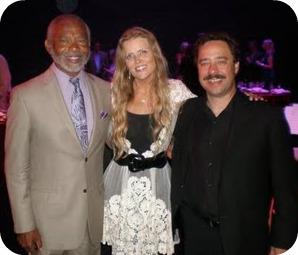 Must Believe in Spring." The intimacy of their blend, interaction and regard for one another was evident. Introducing "All The Things You Are," which flowered into spontaneous counterpoint, Sutton said, "This is sort of like chamber music, isn't it?"
Must Believe in Spring." The intimacy of their blend, interaction and regard for one another was evident. Introducing "All The Things You Are," which flowered into spontaneous counterpoint, Sutton said, "This is sort of like chamber music, isn't it?"
"That's exactly what it is," Laws said.
Koonse began a stately "Ill Wind" with a slow chorus leading into Sutton's vocal supported by obbligato from Laws. Chamber music, yes, and art song as effective as Schubert or Wolff. If the ballads were redolent of music from the romantic period, the up-tempo pieces had the bite of bebop. In "'S Wonderful" Sutton made effective use of melisma at warp speed. "Joy Spring" had Sutton and Laws in a wordless unison chorus, then Sutton nailing Jon Hendricks' ingenious lyric, followed by Laws' blistering piccolo solo, Koonse chording his solo, and Sutton and Laws wrapping it up in an exchange of fours. Other highlights: the groove intensifying through "Lullaby of the Leaves;" Sutton's beautiful reading of Gene Lees' lyric to Bill Evans' "Very Early;" Laws' evocation of Ravel as Sutton sang Alan and Marilyn Bergman's words to Dave Grusin's "A Child is Born;" the empathy of Koonse and Laws in their duet on "Stella by Starlight."
Throughout, the trio listened, tuned and adjusted to one another. The sense of mutual appreciation on stage was palpable. The concert ran a good half hour past its scheduled conclusion. No one seemed to mind. Near the end, as she was introducing "Cherokee," Sutton told of placing third years ago in a Thelonious Monk vocal competition. Of the unnamed first and second place winners she said, "They're not doing a gig tonight with Hubert Laws and Larry Koonse." The three will continue to go their own ways, Sutton leading the Tierney Sutton Band ("I'm here tonight with their permission," she said), Laws and Koonse traveling the world to perform. They say that they will appear together as often as possible and that they will record. That is something to look forward to.
The few precedents of music for voice, guitar and flute seem to be outside of jazz. Igor Stravinsky came close to the combination with "Four Russian Songs" for voice, flute, guitar and harp, as did the contemporary American composer Daniel Asia with a series of "Sacred Songs" for voice, flute, guitar and cello. The operatic soprano Victoria de los Angeles recorded a group of Sephardic songs from the Spanish renaissance with flute and guitar accompaniment. "Pure Land," a setting by the Serbian-American composer Dušan Bogdanović, is for flute, guitar and poetry of Patricia Capetola. It appears not to have been recorded. Brazilian guitarist Laurindo Almeida arranged pieces by Fauré and Schubert for voice, flute and guitar. Here is Fauré's "Pavane" played by Almeida with mezzo-soprano Salli Terri and flutist Martin Ruderman.
In conversation with a casual listener who said he wanted to know more about jazz, I mentioned that the creation of melody in improvisation is not limited to what are generally considered melody instruments. I said that some drummers play melodic, even lyrical, solos.
"What do you mean?" he said, clearly puzzled. I tried, rather clumsily, I'm afraid, to explain that through combinations of phrasing, dynamics and tone control, a drummer who is so inclined (not all are) can create trains of musical thought as cogent as those of a horn player. I mentioned a few names, beginning with Jo Jones. They meant nothing to the man. I didn't think he was buying my proposition. I promised to look for an example and alert him.
For my acquaintance, and for anyone else interested, here's a case in point. Joe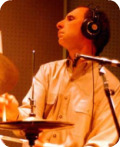 LaBarbera is one of the contemporary masters of melodic drumming. In the 1979 video clip below, he is featured with Bill Evans's last trio. Marc Johnson is the bassist. LaBarbera solos with wire brushes and with sticks, and exchanges phrases with Johnson. Concentration on not only LaBarbera's rhythm but also, to borrow Lester Young's term, his story-telling, may help our friend grasp the concept.
LaBarbera is one of the contemporary masters of melodic drumming. In the 1979 video clip below, he is featured with Bill Evans's last trio. Marc Johnson is the bassist. LaBarbera solos with wire brushes and with sticks, and exchanges phrases with Johnson. Concentration on not only LaBarbera's rhythm but also, to borrow Lester Young's term, his story-telling, may help our friend grasp the concept.
One further thought before you click on the play button: in this year before Bill Evans died, he more and more often returned to the muscularity that characterized his playing in the late 1950s and early '60s. In this version of a tune that he loved, that strength is apparent.
Cycling is in full, if often chilly, swing. Fruit trees and wildflowers are blossoming. On today's 30-mile expedition through the back country heights, I came across this field in bloom and didn't want to keep it to myself.
"Hello To The Season,"( to quote the title of a piece from Gary McFarland's Point of Departure with Richie Kamuca, Jimmy Raney, Willie Dennis, Steve Swallow
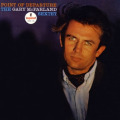 and Mel Lewis). I thought that this exquisite 1963 album had long since lapsed into unavailability. But this web site claims to have it as a CD. If that is true, run, don't walk, to order it while it's still around. At any moment, it could disappear again.
and Mel Lewis). I thought that this exquisite 1963 album had long since lapsed into unavailability. But this web site claims to have it as a CD. If that is true, run, don't walk, to order it while it's still around. At any moment, it could disappear again.
I have no idea how Sharkey Bonano (see the April 9 item below) felt about Art Farmer's playing or, indeed, whether he was aware of Farmer. They were from different eras and different styles. My guess is that Farmer's lyricism would have appealed to Bonano, whose own playing carried a trace of Bix Beiderbecke DNA.
In this video from a 1966 program on the Dutch TV station NCRV, Farmer collaborates on "Just Friends" with alto saxophonist Lee Konitz and the Swedish trombonist Ake Persson. The rhythm section is pianist Pim Jacobs' trio, with Stu Martin on drums. We don't see the bassist, but most likely he is Ruud Jacobs, his brother's more or less constant sideman during this period. The date was under Oliver Nelson's leadership. Near the end of the performance, we catch a glimpse of Nelson and his tenor saxophone.
Sharkey Bonano was born on this day 98 years ago. He died in 1972. During my first residency in New Orleans, I was fortunate that Sharkey was still around and working. Late in his career, when Bonano was able to resist his cornball urges, he was capable of superb trumpet playing of the kind he did in the 1920s and '30s with Gene Goldkette, Ben Pollack and his own Sharks of Rhythm. In this photograph from 1968 or so, he is in his customary derby standing next to Pete Fountain at an impromptu jam session. It was the first time in a quarter of a century that Fountain had set down his clarinet and played tenor saxophone, something he has rarely done since. The trombonist in the picture is Eddy Edwards, a survivor of the Original Dixieland Jazz Band. The clarinetist is Harry Shields, brother of Larry Shields, the original clarinetist of the ODJB. The drummer's name escapes me, but one of you alert Rifftides readers will let me know. 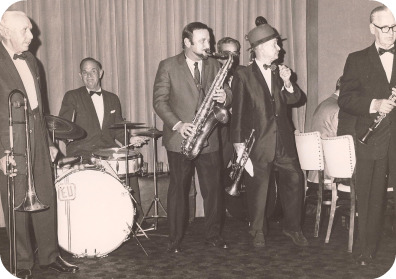
Bonano is usually described as under the influence of Louis Armstrong. That is true, but he rubbed up against Bix Beiderbecke in Goldkette's band and, ever after, ripples of Bix surfaced in his work. In the soundtrack of the shaky amateur photo montage below, you will hear traces of both Armstrong and Beiderbecke as Bonano leads a superb version of his band through "High Society." The front line includes two young New Orleans stars, clarinetist Irving Fazola and trombonist Santo Pecora. Sharkey's former leader, Pollack, is on drums, Thurman Teague bass and Frank Frederico, guitar. The pianist is the 19-year-old Clyde Hart, later to make the transition to bebop and play with Charlie Parker and Dizzy Gillespie. Listen to the ease with which Fazola nails the traditional Alphonse Picou clarinet solo. From Sharkey, Faz went on to Glenn Miller, Bob Crosby and Claude Thornhill, among others.
This is a fine memory of Sharkey Bonano.
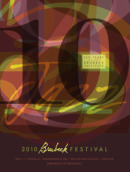 The 2010 Brubeck Festival opens today at the University of the Pacific in Stockton, California. Occasional Rifftides contributor Paul Conley of Capitol Public Radio in Sacramento spoke with Dave and Iola Brubeck about the history of the institute. Among the stories is Brubeck's recollection of the early connection between one of his brothers and an emerging young band leader and arranger named Gil Evans. To hear Paul's report, go here and click on "Listen."
The 2010 Brubeck Festival opens today at the University of the Pacific in Stockton, California. Occasional Rifftides contributor Paul Conley of Capitol Public Radio in Sacramento spoke with Dave and Iola Brubeck about the history of the institute. Among the stories is Brubeck's recollection of the early connection between one of his brothers and an emerging young band leader and arranger named Gil Evans. To hear Paul's report, go here and click on "Listen."
Kirk Knuffke, Amnesia Brown (Clean Feed). Knuffke's trumpet tone is notable for softness, fullness and evenness. The audacity of risk in his improvisational concept would be the envy of the Flying Wallendas. The contrast between his sound and the content of his work is a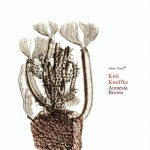 source of fascination throughout this collection of miniatures. Even though his collaborators number only two, Knuffke has plenty of company in 16 little art songs without words, all his compositions. Drummer Kenny Wollesen is a three-decades veteran of adventures with musicians as various as John Zorn, Bill Frisell, Jessica Williams, Tom Waits, Sean Lennon and the Crash Test Dummies. Doug Wieselman's track record includes work with Zorn, Jenny Scheinman, Wayne Horvitz and other prominent artists who typically populate the edge of New York's downtown jazz community. From track to track, he alternates between clarinet (generally calm) and guitar (tending toward mania).
source of fascination throughout this collection of miniatures. Even though his collaborators number only two, Knuffke has plenty of company in 16 little art songs without words, all his compositions. Drummer Kenny Wollesen is a three-decades veteran of adventures with musicians as various as John Zorn, Bill Frisell, Jessica Williams, Tom Waits, Sean Lennon and the Crash Test Dummies. Doug Wieselman's track record includes work with Zorn, Jenny Scheinman, Wayne Horvitz and other prominent artists who typically populate the edge of New York's downtown jazz community. From track to track, he alternates between clarinet (generally calm) and guitar (tending toward mania).
The three develop their solos and interactions from themes built on folk simplicity in "Leadbelly" and "Totem," instrumental chanting in "Practical Sampling" and serene trumpet layered over guitar distortions and raucous drum and cymbal patterns in "Please Help, Please Give." The album's opening "How it Goes" begins with trumpet/clarinet counterpoint that could be Knuffke reflecting on Shorty Rogers and Jimmy Giuffre circa 1954, however unlikely that may seem. It ends with lyricism,  Knuffke and Wieselman giving sotto voce unison farewell to the delicate melody of "Anne." The unusual name of the album's title tune? It memorializes one of Knuffke's great-grandfathers, who claimed that he forgot he had a wife and family after he established a second set in another town and changed his name. The piece has a nostalgic, even old-timey, quality and a certain goofiness in the solos that is underlain with a Wollesen percussive effect like rapid water over loose stones.
Knuffke and Wieselman giving sotto voce unison farewell to the delicate melody of "Anne." The unusual name of the album's title tune? It memorializes one of Knuffke's great-grandfathers, who claimed that he forgot he had a wife and family after he established a second set in another town and changed his name. The piece has a nostalgic, even old-timey, quality and a certain goofiness in the solos that is underlain with a Wollesen percussive effect like rapid water over loose stones.
In a development that may be an indication of growing maturity in free jazz, the longest track runs less than five minutes. Perhaps, after all, full expression doesn't require extraordinary length. One thinks of Miles Davis's celebrated advice to John Coltrane when Coltrane explained that he had trouble stopping his solos; "You might try taking the horn out of your mouth." These guys do, and it works.
For the past six months or so, Knuffke has been a member of Matt Wilson's quintet. For a Rifftides review of one that band's performances shortly after he joined, go here.
Yesterday was Gerry Mulligan's birthday (1927-1996). Today is Billie Holiday's (1915-1959). If only there were video of them together.
There is, of course; one of the most famous pieces of film ever made of a jazz performance. It is from the kinescope recording of the 1957 CBS-TV program The Sound of Jazz. "Fine and Mellow" featured Holiday with a group of horn soloists for which the designation All-Stars seems barely adequate. Holiday's choruses of her classic blues alternate with solos by Ben Webster, Lester Young in an inexpressibly moving reunion with Holiday, Vic Dickenson, Mulligan, Coleman Hawkins and Roy Eldridge. The muted trumpet obbligato is by Doc Cheatham. Seeing this every so often is like revisiting a great painting. Its depth grows with each viewing.
Jazz this week lost John Bunch, a pianist whose imagination and adaptability kept him in demand for more than 60 years. Establishing his career in New York following his World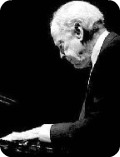 War Two military service, Bunch slid smoothly from swing into bop and remained a reliable sideman and soloist who incorporated aspects of both eras in a personal approach of great flexibility. He was as comfortable and effective with Benny Goodman as he was with Wes Montgomery, or alone. This celebrated album is a superb Bunch solo recital. To read Nate Chinen's obituary of Bunch in The New York Times, go here.
War Two military service, Bunch slid smoothly from swing into bop and remained a reliable sideman and soloist who incorporated aspects of both eras in a personal approach of great flexibility. He was as comfortable and effective with Benny Goodman as he was with Wes Montgomery, or alone. This celebrated album is a superb Bunch solo recital. To read Nate Chinen's obituary of Bunch in The New York Times, go here.
Bunch leads off a round of solos on "Sweet Georgia Brown" in this video of Scott Hamilton's quartet. Chris Flory is on guitar, Phil Flanigan, bass and Chuck Riggs, drums.
That's quite enough passings for a while, don't you agree?
Last summer, I had the privilege of presenting the 2009 Lifetime Achievement Award of the Jazz Journalists Association to Mike Zwerin, my successor in the chain of winners of that honor. Mike was unable to make the trip from his home in France and accepted in absentia. That missed opportunity meant that I will never have the pleasure of a 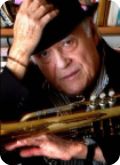 personal meeting with a cherished colleague. Mike died early this morning in a Paris hospital at the age of 79, following a long illness. Our correspondence over the years provided me insights and great satisfactions. His end of it was witty and acerbic, in keeping with his columns in the International Herald Tribune and, in later years, Bloomberg News.
personal meeting with a cherished colleague. Mike died early this morning in a Paris hospital at the age of 79, following a long illness. Our correspondence over the years provided me insights and great satisfactions. His end of it was witty and acerbic, in keeping with his columns in the International Herald Tribune and, in later years, Bloomberg News.
Zwerin's books Swing Under The Nazis: Jazz As A Metaphor For Freedom and The Parisian Chronicles are essential items in any serious collection of writing about jazz. His first fame was as a fine valve trombonist and bass trumpeter, a member of the original Birth of the Cool band led by Miles Davis in collaboration with Gerry Mulligan, Gil Evans and John Lewis. In his journalism career, in addition to his award-winning work for the International Herald-Tribune, he wrote for The Village Voice, Rolling Stone and Down Beat, among other publications. Mike's writing style inspired Bill Kirchner to describe him as "Mezz Mezzrow meets Jack Kerouac meets Hunter Thompson." Zwerin provided a rare combination of wisdom and spice. His readers, this one most emphatically included, will miss him.
AJ Ads
AJ Blogs
AJBlogCentral | rssculture
Terry Teachout on the arts in New York City
Andrew Taylor on the business of arts & culture
rock culture approximately
Laura Collins-Hughes on arts, culture and coverage
Richard Kessler on arts education
Douglas McLennan's blog
Dalouge Smith advocates for the Arts
Art from the American Outback
Chloe Veltman on how culture will save the world
For immediate release: the arts are marketable
No genre is the new genre
David Jays on theatre and dance
Paul Levy measures the Angles
Judith H. Dobrzynski on Culture
John Rockwell on the arts
innovations and impediments in not-for-profit arts
Jan Herman - arts, media & culture with 'tude
dance
Apollinaire Scherr talks about dance
Tobi Tobias on dance et al...
jazz
Howard Mandel's freelance Urban Improvisation
Focus on New Orleans. Jazz and Other Sounds
Doug Ramsey on Jazz and other matters...
media
Jeff Weinstein's Cultural Mixology
Martha Bayles on Film...
classical music
Fresh ideas on building arts communities
Greg Sandow performs a book-in-progress
Harvey Sachs on music, and various digressions
Bruce Brubaker on all things Piano
Kyle Gann on music after the fact
Greg Sandow on the future of Classical Music
Norman Lebrecht on Shifting Sound Worlds
Joe Horowitz on music
publishing
Jerome Weeks on Books
Scott McLemee on books, ideas & trash-culture ephemera
theatre
Wendy Rosenfield: covering drama, onstage and off
visual
Public Art, Public Space
Regina Hackett takes her Art To Go
John Perreault's art diary
Lee Rosenbaum's Cultural Commentary
